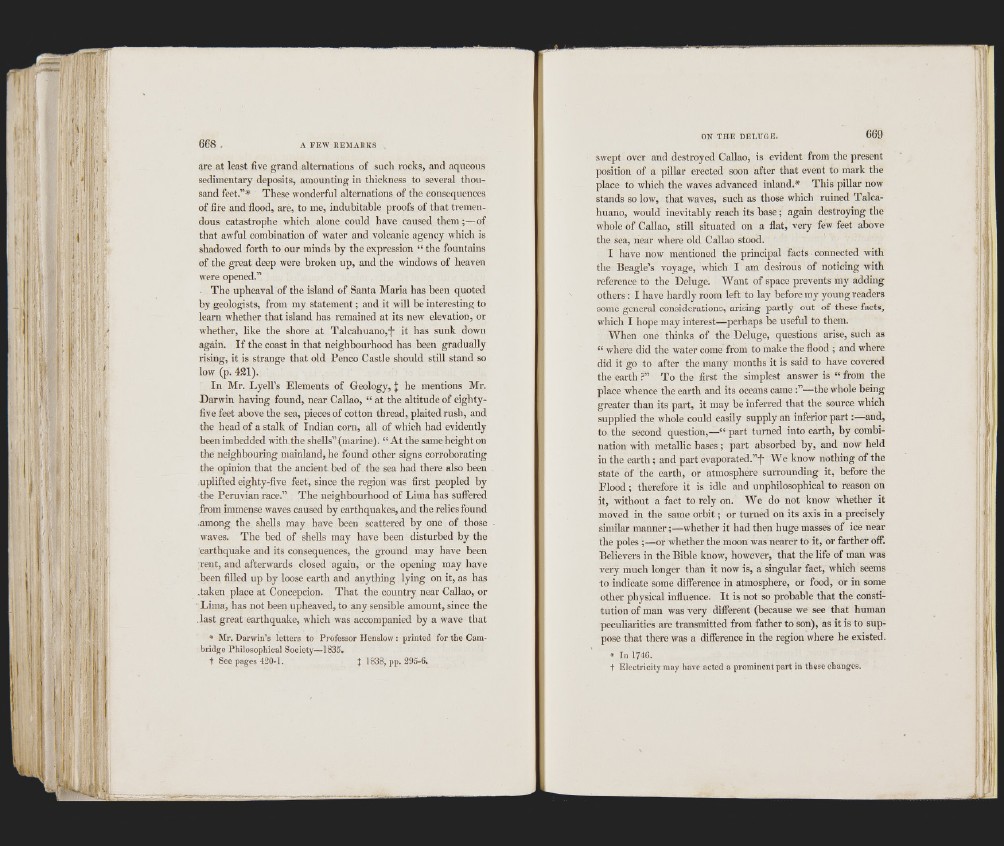
are at least five grand alternations of such rocks, and aqueous
sedimentary deposits, amounting in thickness to several thousand
feet.”* These wonderful alternations of the consequences
of fire and flood, are, to me, induhitahle proofs of that tremendous
catastrophe which alone could have caused them;—of
that awful comhination of water and volcanic agency which is
shadowed forth to our minds hy the expression “ the fountains
of the great deep were broken up, and the windows of heaven
were opened.”
The upheaval of the island of Santa Maria has been quoted
by geologists, from my statement; and it will be interesting to
learn whether that island has remained at its new elevation, or
whether, like the shore at Talcahuano,# it has sunk down
again. I f the coast in that neighbourhood has been gradually
rising, it is strange that old Penco Castle should still stand so
low (p. 421).
In Mr. LyelFs Elements of Geology, ] he mentions Mr.
Darwin having found, near Callao, “ at the altitude of eighty-
five feet above the sea, pieces of cotton thread, plaited rush, and
the head of a stalk of Indian corn, all of which had evidently
been imbedded with the shells” (marine). “ At the same height on
the neighbouring mainland, he found other signs corroborating
the opinion that the ancient bed of the sea had there also heen
uplifted eighty-five feet, since the region was first peopled hy
the Peruvian race.” The neighbourhood of Lima has suffered
from immense waves caused by earthquakes, and the relics found
among the shells may have been scattered by one of those
waves. The bed of shells may have been disturbed by the
earthquake and its consequences, the ground may have been
rent, and afterwards closed again, or the opening may have
been filled up by loose earth and anything lying on it, as has
.taken place at Concepcion. That the country near Callao, or
Lima, has not been upheaved, to any sensible amount, since the
last great earthquake, which was accompanied by a wave that
* Mr. Darwin’s letters to Professor Henslow: printed for the Cambridge
Philosophical Society—1835.
t See pages 420-1. J 1838, pp. 295-6.
Jl I
swept over and destroyed Callao, is evident from the present
position of a pillar erected soon after that event to mark the
place to which the waves advanced inland.* This pillar now
stands so low, that waves, such as those which ruined Talcahuano,
would inevitably reach its base; again destroying the
whole of Callao, still situated on a flat, very few feet above
the sea, near where old Callao stood.
I have now mentioned the principal facts connected with
the Beagle’s voyage, which I am desirous of noticing with
reference to the Deluge. Want of space prevents my adding
others: I have hardly room left to lay before my young readers
some general considerations, arising partly out of these facts,
which I hope may interest—perhaps be useful to them.
When one thinks of the Deluge, questions arise, such as
“ where did the water come from to make the flood ; and where
did it go to after the many months it is said to have covered
the earth To the first the simplest answer is “ from the
place whence the earth and its oceans came —the whole being
greater than its part, it may he inferred that the source which
supplied the whole could easily supply an inferior p a rt:—and,
to the second question,—“ part turned into earth, by combination
with metallic bases; part absorbed hy, and now held
in the earth ; and part evaporated.”# We know nothing of the
state of the earth, or atmosphere surrounding it, before the
Flood ; therefore it is idle and unphilosophical to reason on
it, without a fact to rely on. We do not know whether it
moved in the same orbit; or turned on its axis in a precisely
similar manner;—whether it had then huge masses of ice near
the poles ;—or whether the moon was nearer to it, or farther off.
Believers in the Bible know, however, that the life of man was
very much longer than it now is, a singular fact, which seems
to indicate some difference in atmosphere, or food, or in some
other physical influence. I t is not so probable that the constitution
of man was very different (because we see that human
peculiarities are transmitted from father to son), as it is to suppose
that there was a difference in the region where he existed.
• In 1746.
t Electricity may have acted a prominent part in these changes.
f! .1